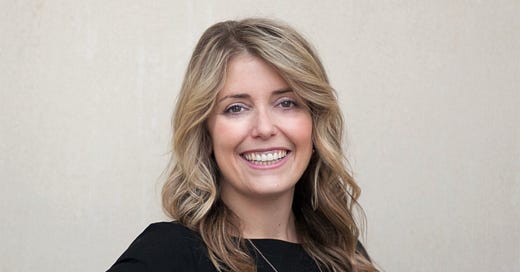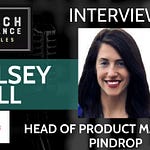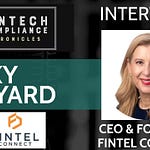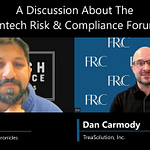(Note - all views are those of Fintech Compliance Chronicles/my personal views and not affiliated with any other organization)
Last week I had the pleasure of attending Fintech Meetup 2025 - my first time attending. I’ve already shared my broad thoughts here, but one thing I also had the opportunity to do was record some great conversations with fantastic leaders in the space on the topic we all know and love here, compliance. This week I’m featuring the first in a series of discussions from the event, with my first being with Laura Kornhauser, CEO of Stratyfy.
Stratyfy is “on a mission to accelerate financial inclusion by providing greater transparency and less bias to critical financial decisions that impact millions of people. Stratyfy's interpretable AI solutions enable financial institutions to make more accurate, efficient, and fair financial decisions in credit risk, fraud, and compliance.”
Some background about Laura: “Laura Kornhauser is the co-founder and CEO of Stratyfy, where her team’s mission is to accelerate financial inclusion by providing greater transparency and less bias to critical financial decisions that impact millions of people. A known thought leader, Laura speaks frequently on the application of AI in financial services and practical methods for addressing bias in data and decisioning. Laura has two decades of experience as a financial services leader, working with financial institutions, technology providers, and regulators to advocate for the use of transparent, responsible AI and machine learning (ML) in the financial sector. Prior to founding Stratyfy, Laura was an Executive Director at JP Morgan Chase, where she focused on developing risk strategies and products for the bank and its largest corporate/institutional customers. Throughout her career, Laura has championed the use of ML to drive financial inclusion – including as a founding member of MoreThanFair, a research participant in the groundbreaking study on fairness in ML with FinReg Lab and Stanford University, and an expert contributor for MIT’s AI Policy Forum. She has a BSE in Operations Research and Financial Engineering from Princeton University and an MBA from Columbia Business School. During her time at Princeton, Laura was recognized for her prescient thesis that correctly identified, quantified, and predicted the inflating housing market bubble years before its collapse. Laura has received the Inspiring FinTech Female Award twice, was named to Innovate Finance’s Women in FinTech Powerlist, and won BAI Global Innovation Rising Star Award in 2023.”
I really enjoyed this conversation - as you can tell, we both got pretty fired up about financial inclusion, the intersection of fraud and compliance, and AI. Thank you to Caliber for setting up the discussion and to Laura for making the time! The transcript of our discussion is below and the recording is at the beginning - the first of what we hope to be a more regular podcast series (prior episodes can be found here on YouTube) - enjoy:
Zarik: It's a pleasure to meet you, Laura. Excited to talk to you about Stratyfy and some of your products like Unbiased, which is the one that interested me the most. And also your partnership with FIS, I was intrigued by that.
So elevator pitch. Stratyfy - how did you come about starting, creating this organization, products that you have? What was the inspiration, motivation, et cetera. Let's start with that.
Laura: Yes. So at Stratyfy we help financial institutions make better decisions across credit, risk, and compliance.
Laura: When we say better, we mean more efficient, more profitable, and fair. That's our definition of better. We're focused on decisions like who to lend to, who to approach for your products, and what types of transactions or behavior to stop for fraud, these are the types of decisions we're talking about.
Laura: Prior to starting Stratyfy almost eight years ago, I spent over a decade at JP Morgan Chase in both lending and risk roles. I come from a family of entrepreneurs. My parents started a technology company around the time I was born and then built and grew it for the next 30 years before selling to a strategic.
So I always had entrepreneurial hopes and dreams, went the very different route initially out of school. And while I was at JP Morgan, I actually, as I mentioned, worked in lending and risk and towards the end of my time there, I was responsible for our quantitative investment solutions. So those were our algorithmic trading strategies that we were selling to corporates and institutions.
And it was also around the time that Dodd Frank came out. And if you recall when Dodd Frank came out, it was very unclear what was in scope, what was out of scope for Dodd Frank. It was very unclear how to comply with that regulation. And we basically ran into a brick wall where we had this huge new product category while getting ready to launch and we weren't going to be able to launch the products because they came under scope of Dodd Frank and we didn't have the proper technology to disclose as we needed to.
Zarik: Even in a large institution like JP Morgan?
Laura: Yes, and the tech team couldn't build it. I often joke that our tech, we went to our tech team and they said, well, we'll get it done in Q5.
Because tech teams at a lot of financial institutions are overwritten by managing existing systems. And often don't have the bandwidth and sometimes even the mandate to do other things, right? So I ended up scotch taping something with one of my engineering friends together, nights and weekends, it wasn't pretty, but it got the job done. We were able to launch the product, but that was a big aha moment for me. decided to quit. People thought I was crazy. I went back to business school full time.
Zarik: Where did you go?
Laura: I went to Columbia.
Zarik: Okay, cool.
Laura: I wanted to stay in New York City because I knew I knew I wanted to stay in the FinTech scene, if you will, and then, was fortunate through a friend to meet my co founder, Dmitry.
He had spent about a decade developing the technology that's still at the core of our products. He was a quant at a trading shop looking for a better way to make decisions. He was very early on in the AI wave and really believed that there’s a lot that we could do with AI, but still human contextualization of information was going to remain important. That was what he was building with his tech. I thought it was super cool. And this -
Zarik: - was in -
Laura: 2017. Yeah, that's when we met.
Zarik: That's really cool. So he was a quant, you are also a quant, working at JP Morgan. I'm just curious, from that experience to building Stratyfy - what were some of the key learnings? I imagine when you were at JPMorgan, complex sort of decisioning happening. You've talked about some of the challenges you had in adapting the technology to Dodd Frank requirements.
Were you able to get into the guts of some of the decisioning, especially from a credit perspective and then how did you leverage some of that learning at Stratyfy when you were building the product?
Laura: Yeah, absolutely. I would say the biggest thing that we realized, and I'd love to say we realized it on day one, it took a little longer, but we always knew that it was really important to be able to bring - we always knew it was important to be able to bring the advancement in technology to where your customers were, right? And bridge that gap between what is possible with cutting edge technology and what is actually happening at your institutions right now.
Zarik: Yeah.
Laura: So we always were really focused on how do we bridge that gap? How do we give people, the visibility and control to feel empowered to start using more advanced analytics, which is ultimately what our software is all about.
What I think we didn't fully appreciate when we started, which we've definitely learned now, is that we had a vision from day one that all of these different areas of risk I mentioned - credit, fraud, compliance - all have inner workings and should have interoperability. I should be able to see what happens in a fraud check when I'm then evaluating a decision of lending or not lending to someone.
And then when I'm looking at that decision afterwards to make sure that I had, the proper compliance controls across that decision - that should be kind of a unified view.
Zarik: Yeah.
Laura: It's not today.
Zarik: You would think it should be because some of the same attributes are getting, different combinations maybe, but -
Laura: I think we're still seeing that in the market today in the fraud space, right? Many, solutions focus on one type of fraud or their point solution for one type of fraud. What happens, when you're looking across an entity and seeing, maybe their score on this type of fraud wasn't enough to trigger an action, but cumulatively we should be looking into this further. It's still a pain point. We realized we wanted to solve all that right out of the gates.
Zarik: I love that you brought up that point because I think what I've seen from a lot of solutions is so much of “Fraud equals Fincrime and AML” and there's so many other dimensions of fraud. And card not present seem to have been forgotten. Maybe they're not explicitly tied to a regulatory requirement like BSA, KYC, AML, but at the end of the day, they're still going to impact your institution. You're still going to lose money. It seems like that just gets lost in the shuffle. From a safety and soundness perspective, to a regulator, if you lose a lot of money for fraud, if you have a breach, they are going to care about that.
Laura: And then that puts your whole growth strategy, depending on what size of bank you are, in jeopardy, as well as many other things. So we always had and continue to have that same vision. But what we realized after starting the company is that it's very hard for a financial institution to buy that solution out of the gates. So what we've done with our products is we've broken them down almost into their building block pieces.
There's still the interoperability between all of them. So what we do in credit and what we do in fraud and what we do in compliance, there's that interoperability, but we allow a customer to have an entry point at different places and not need to fight everything off all in one go. And that goes to meeting the customer where they are and what they're ready for.
And yes, having opportunities to grow with them, but not asking for all of it to happen out of the gates. I'd say that's our biggest learning.
Zarik: Yeah. I love that you mentioned the customer centricity. Because so many times, a lot of these offerings, they talk about the customer being the end partner bank or the end fintech, or the end credit union, but the actual person who they’re all trying to help - the customer, the user - is sort of forgotten in the shuffle.
Laura: Yes. And we are very much a B2B company, but everything we're trying to enable is all about what happens in the B2C.
Zarik: That's cool. So I want to shift and talk a little bit about the offerings that you have. Talk to me a little bit - let's start with Unbiased because that's the one that stood out to me. What is Unbiased? And am I right to say that's kind of the main offering at Stratyfy?
Laura: So, I would say that it's one of three main offerings, right? And, that's our main offering in the compliance space.
It actually came out of our offering in the credit space. When we were in the credit decisioning, the place we started was how do we help lenders make better decisions throughout a loan life cycle? Though, primarily it's that approve / decline decision that they're making on a borrower and associated terms after that.
We always believed that one of the ways you should evaluate a given model or decisioning strategy is on the metrics of biases or fairness measures. Just like I may compare a AUC or KS between two models, I may look at two decisioning strategies and see what's my expected approval rate, my expected default rate.
I should also be able to look across two strategies and say, okay, what's my disparate impact. Right? Across different protected classes is one of these strategies raise fairness concerns or issues, while another one does not. You can almost think of it as that less discriminatory alternative search or mindset upfront.
We received such positive feedback on that, if you will, fairness piece alone, that we spun it out such that it can be available. Even if someone built their models and decisioning strategies using another provider, that's kind of the genesis of where Unbiased came from.
Zarik: One thing I was thinking when I was looking at the product and I was thinking back to past life and my own experience was the concept of disparate impact, maybe more so from a third line perspective. We were told - don't design any tests to look for disparate impact.
Because if you do, you're creating a paper trail that a regulator is going to be able to grab and say, boom, we got you. So that was a legitimate risk that, some of the folks who were advising us from the legal side - this is like 10 plus years ago, so I don't mind talking about this - but they saw that as a risk.
In my mind it didn't make sense. Wouldn't you want to know if you're doing that? I get that you don't want to gift wrap something for a regulator, but at the same time, do the right thing.
Laura: That’s the see no evil, hear no evil approach that still exists in the market today.
Zarik: How do you deal with that? Have you dealt with that as you've tried to bring this to market and what's your mechanism around it? Do you just not work with institutions like that?
Laura: Yes, we deal with this today. I would say it's a dying viewpoint, for lack of a better term. Two and a half years ago when we first launched this new product, I spoke with a Chief Compliance Officer at a large community bank who told me, “I don't want you to pick up a rock because if I know what you found underneath, I have to find it.” Hence the see no evil hear no evil mantra. So, it exists. It's dying. Right? And I think that that is because, historically, it was very hard to do this type of testing on a frequent and robust basis.
So it was like anything, maybe you don't sleep very well at night, but if you don't know about it, you can't say that you didn't do something about a problem. You knew about where we are today. Technology like what Stratyfy offers enables a financial institution to do this type of testing on a frequent basis, in a robust manner, in a proactive fashion.
So what we're seeing now is folks - regulatory bodies, industry groups - that are focused on seeking out this kind of behavior and as a result have been pushing more on institutions to say, okay, show me where you tested things. The law says you have to test it, right? It's very clear in the law that you have to test it, so, that has made it harder for people to hide behind this.
Zarik: Very old school mindset.
Laura: But it still exists. It's still there. It's an increasingly smaller population of folks feeling that way. Increasingly professionals in the space recognize that it's worth the time and effort to get the stuff right the first time.
The other thing that's changing is folks are also realizing that it's good for their business. And so this is not just a, “I'm going to check the blocks on compliance.” I also have an opportunity to find a way to extend capital to a new customer base.
Zarik: Yeah. That have never been marketed to, or are new to credit.
Laura: You want to create the most loyal customer of all time. Do that, find that person and then nurture that relationship and don't compete for a basis point here or there in the super prime area. Find ways to find the good folks, that are a bit more out the risk spectrum and more and more lenders are recognizing the profitability benefit of that, and the growth benefit of that.
Zarik: Yeah. I think just given how saturated banking, at least in the U S seems, why wouldn't you want to tap into a untapped base of customers? But let's rewind a little bit.
You talked about the regulators. You were working in a large regulated institution, so I'm sure you had your encounters, directly or indirectly, with regulators. In Stratyfy, your experience with this company, what have your interactions with regulatory bodies been like, what kind of feedback have they given you or indirectly, what have you heard through some of your clients?
Laura: Yeah.
Zarik: Would love to get some of that perspective.
Laura: So part of our strategy since day one of founding the company was to form relationships across the regulatory body, across the regulators. We have always had the view that we want them to know us. We want them to know what we're doing.
We want them to know about the type of change we're trying to drive. We want them to understand that there's a way to leverage AI, more specifically machine learning technology, without it being a black box. And that there's different levels of transparency, and you have to ask things like, who is this transparent to?
Is it just transparent to the data scientists on your team? Or is it transparent to the subject matter experts, the compliance professionals, the external and internal audit committees, for example. So we wanted to be the ones talking to them about these topics. And we found a very strong reception across the regulatory bodies.
And we encourage this with all of our customers. And most of our customers already have this position. If they don't, we encourage it. You know, the worst thing you can do is hide from your regulators.
The worst thing you can do, going back to our previous topic, is not be the person that found the problem.
You always want to be the person that found the problem and did something to remediate it. The regulators, they've said it to us, they've said it to our customers - they view that very favorably.
Zarik: I'm curious if you've seen this as well - when I was at Discover, the institution I worked at years ago, we launched free FICO scores, which at the time, why would anybody do that?
The regulators actually cited it and they said, we like this. And then, some of our peers and rivals followed suit. So in the same vein, I think that kind of feedback will come at some point.
Laura: And that's part of our commitment, right? Teamwork is a core value of ours. We believe in that collaborative nature. It extends to our customers, our partners and the regulator. And that's how we want to work with them. We find that there's this belief that regulators are anti-innovation. We find that is not the case whatsoever. They're actually very pro innovation. They just want to make sure it's coming from folks that understand what's going on in the industry and understand the uniqueness of financial services versus other industries.
These are decisions that truly impact people's lives. So we think the higher level of scrutiny on those decisions is actually warranted. If you come to a regulator an advocacy group or other groups, and you have a proposition for how to leverage innovation to drive positive change. They are very receptive.
Zarik: Yeah. And I think that's a win for everybody in that case. Talking about the end user who's benefiting from this, a sense I got from looking into and understanding more about your company is a lot of talk about financial inclusion and I'm curious if there's any motivation behind your passion behind making finance and banking, consumer FinTech, more accessible, to those folks we talked about previously, like the new to credit, looking at things like alternative data, et cetera. What would be a motivation or driver behind that for you? Looking at that as an angle, you could certainly say, “Hey, this is great for, businesses.” Clearly there's something more here that I sense when I look at this?
Laura: It comes from at its core to back to the founding story, why we founded this company and why we wanted to do this for me very personally.
It comes from background. My parents - my father's an immigrant, my mom's second generation, right? - came to this country, worked, built themselves up from the bootstraps, blood, sweat and tears to get to a place where they could be business owners. One of the motivators behind why I left my previous job is I really wanted to feel like I was making a positive impact on the world. Financial inclusion is not just about doing the right thing. It is ultimately about contributing positively to our GDP.
It’s actually been shown that when we provide fairly priced financial instruments to a wider group of people our economy thrives. And when we don't it stifles our economic growth. Citi had a report that they put out where they estimated that 16 trillion had been lost in revenue due to biased lending practices since the year 2000.
So it’s not just the right thing to do. It's also good for our economy. That's very inspiring and motivating to me. You may say, there are plenty of ways to do that that aren't in financial services. That's what I know and love. And this is how I make my impact.
And you think about things like, having a fairly priced loan when you lose your job or when you have an unexpected financial expense that changes a person's life. If they can have access to a fair financial product then they can buy their first home, that changes people's life. It's the way that we have wealth accumulation and intergenerational wealth - if they can get the capital to start a small business, these are all the things that give people opportunity and change lives and I wanted to be part of that.
Zarik: I think that's fantastic. And it resonates with me as well because I'm, first generation myself, both my parents are immigrants. This leads into my next question. It's really amazing how it seems to be the same guardrails, almost the same bouncers, if you will, to the club, that everybody seems to need to find a way to get around. [For most people, they will say] “my first credit card was a Discover. And then you slowly build your credit and you get in there. But I'm curious, specifically thinking about the bureaus, the three credit bureaus, do you feel that your product - does it sort of work around them?
Do you see a future where everybody's going to realize that to achieve that goal you're talking about where everybody gets it - financial inclusion means more GDP, better economy, revenue for companies - is everybody going to have to start working around them or are they going to need to look at solutions like yours and others and say maybe we should adapt.
Laura: Yeah, I think it's the latter. I think that there's a place for the credit bureaus, right? We have partnerships with some of the bureaus and relationships with all of them and they get that and know that they want to find a way to better assess the risk for thin file, no file, and get better separation in the lower credit score bands - the same objectives. It's a hard thing. Everything ultimately goes back to a FICO and VantageScore today. And having a three digit number describe 330 million people is a hard thing to do. I expect most scorers that are looking to do a wide purview of things where they need to evaluate, there's always going be this band of credit scores where you need more advanced analytics like what we offer. Or you need supplemental data, more information. You need a better way to pick through to find the goods from the bads - I don't see that need going away anytime soon.
It doesn't mean that there's not still a lot of value that credit scores and the credit bureaus provide. But that need to pick through, the harder stuff, I think is always going to be present.
Zarik: Sure.
Laura: I think it's always going to be present.
Zarik: Those are the diamonds in the rough you're going to miss out.
Laura: You're going to miss out. If you look by the score, it looks quite risky, but -
Zarik: You can't just say 660 FICO.
Laura: 100%. You know, 70 percent of Americans have prime credit scores yet only 50 percent of Americans have - there's a lot of people being missed in there that have never defaulted on a loan product, right? And never had a bad experience with the credit product. They're just not getting access - I love what you said about the bouncer analogy.
People call it financial literacy, and I actually think that's a misnomer. It's understanding the tricks similar to getting by a bouncer at a club, it's their tricks to how to do it. Certain people haven't been taught those tricks.
And, that's why they come from a community that has financial trauma and then doesn't trust the banking sector, often for good reason, right? And that's what's missing. It's more about access to those tricks of the trade than the literacy piece. People always group it under literacy, and I think it's a bit of a misnomer.
Zarik: Yeah, and this will lead me to our last question, because I know we're right at time here, but there's clearly an element of humanity that's been permeating all these questions in this conversation.
I'm curious, even though we're talking about using amazing technology to solve these problems, I'll end with the AI topic, right? How do you see, from your perspective, as more AI use grows in institutions and fintechs and partner banks, do you see increasing risk that these individuals we talked about are going to get increasingly shut out and that they won't be able to access any human being to have some of these considerations? There's a lot of users having their own stories as you talked about for yourself – [in response to that] maybe you see a groundswell of people coming up with AI assisted solutions, but ones that don't forget about the human element. You know what I'm saying?
Laura: That's a phenomenal question. So where to begin? I believe strongly that the right path forward with AI is the second one you outlined with the human assistant.
It's an enabler, not a replacer. It takes over the tasks that are tedious and challenging for humans to do and provides greater information for the humans to ultimately contextualize. We are a long way from an AI system being able to contextualize information, let alone go between different tasks.
But even just in one specific task, it takes that contextualization a long way. being able to do that. Humans are good at it. Let's bring the two together such that the result is better than either of the parts on their own. That is our vision,
I do think that there is a real risk that we don't have the proper checks and balances on the AI - and that is mainly due to the fact that AI learns from data, period, full stop, right? Based on the data that you feed it, it will learn different things. All data is biased. It's not a question of if your data is biased, it's a question of how.
All data is biased. And if the person feeding the data in is not trying do something nefarious - even if someone's not – and they're just feeding it data and they don't have the control and the visibility to understand what biases are embedded in that data, then all we're going to get is faster iterations of the same thing that we've had in the past.
And I don't think anyone would claim that our financial system is perfect. So we have a real risk that the snowballs could start going down the hill and getting larger, and that's why we believe so strongly in smart regulations,
That's not over regulation. It's smart regulation. Smart regulation to us means regulation that's focused on that visibility, that understanding behind what's happening in the AI system, making sure that the humans that are running it and using it to service their customers can trust it. And we believe very strongly that trust doesn't come without that level of understanding of knowledge into how the thing is working.
I can't just know the inputs and the outputs.
Zarik: You have to have that experience.
Laura: And I’ve got to know what's going on in the middle. Otherwise, how can I then allow it to help me do more of the tasks that I would otherwise be doing with any level of confidence?
Zarik: Well, Laura, it's been an absolute pleasure, really appreciate it. Best luck to you at the conference thank you so much.
Laura: Thank you, Zarik. It’s been really great.
Zarik: Likewise.















Share this post